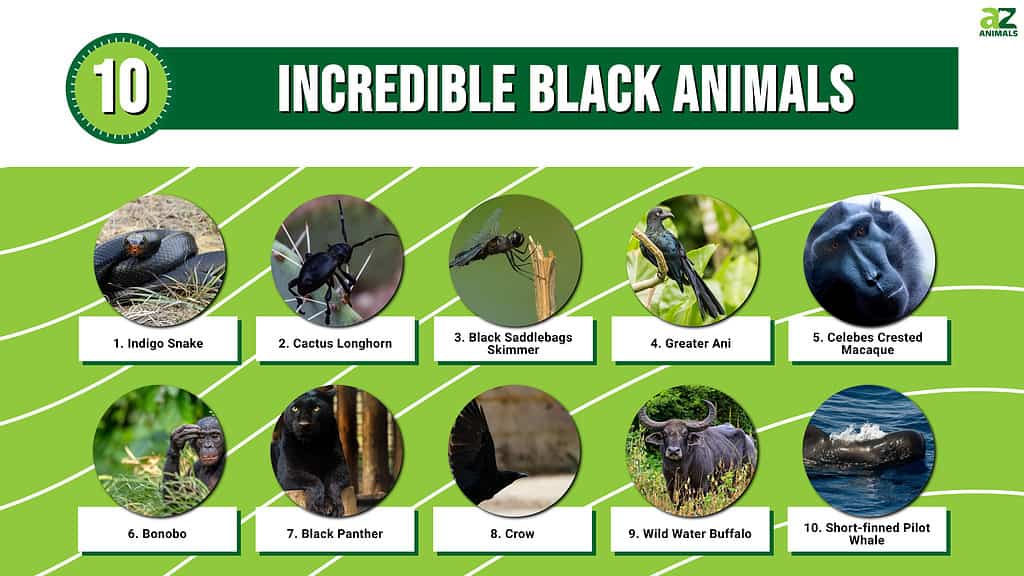
There’s something intriguing about a solid black animal. Some people associate such animals with night, mystery, or even evil. Save one, the black animals listed here mostly belong to species whose coloration is typically solid black when they’re adults. The black panther, which is the result of melanism in the jaguar or the leopard, is just too awesome to be left off of the list! Another criteria for this list is that both male and female members of the species are black, as there are species in which one sex is black but not the other. Check out these 10 incredible black animals!
#10: Short-finned Pilot Whale
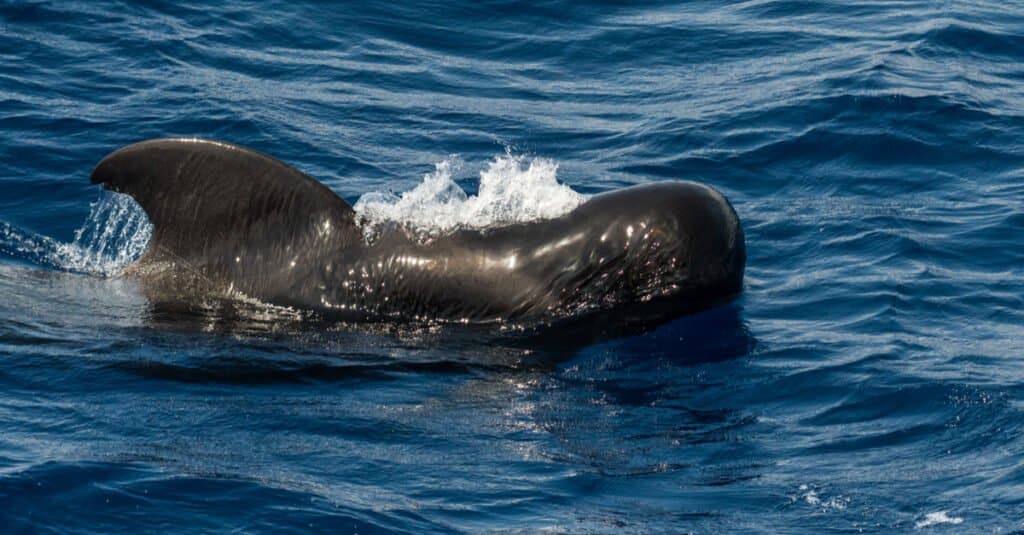
©Marcos del Mazo/Shutterstock.com
These sleek, melon-headed black animals are actually dolphins, not whales, despite their name. They are famous for stranding themselves in numbers. Scientists aren’t sure why these marine mammals do this, although it is thought to be associated with underwater naval testing of low-frequency sound waves that disrupt the dolphin’s ability to navigate through their echolocation.
Pilot whales are often glossy black, though some may have patches of gray or white on the saddle or the dorsal area. Traveling in pods led by a matriarch, females range from 9.8 to 16 feet long, depending on the population, while males are a bit bigger. Females live about 60 years, while males live around 45 years. They’re found in the warmer waters of the Atlantic, Pacific, and Indian Oceans, are protected from hunting, and have a conservation status of least concern.
#9: Wild Water Buffalo

©David Havel/Shutterstock.com
A big water buffalo can stand 6.25 feet at the shoulder weigh a ton or more, but massive as they are, they have been domesticated for millennia. Water buffalo that are still wild are rare and classified as endangered. They are notable for their huge, curved, wrinkled horns, which are the biggest of any in the Bovidae family. Wild water buffalo are found in matriarchal herds led by a cow to the best feeding, watering, and wallowing areas. Males visit during the wet season to mate. Nearly all wild buffalo live in India.
#8: Crow
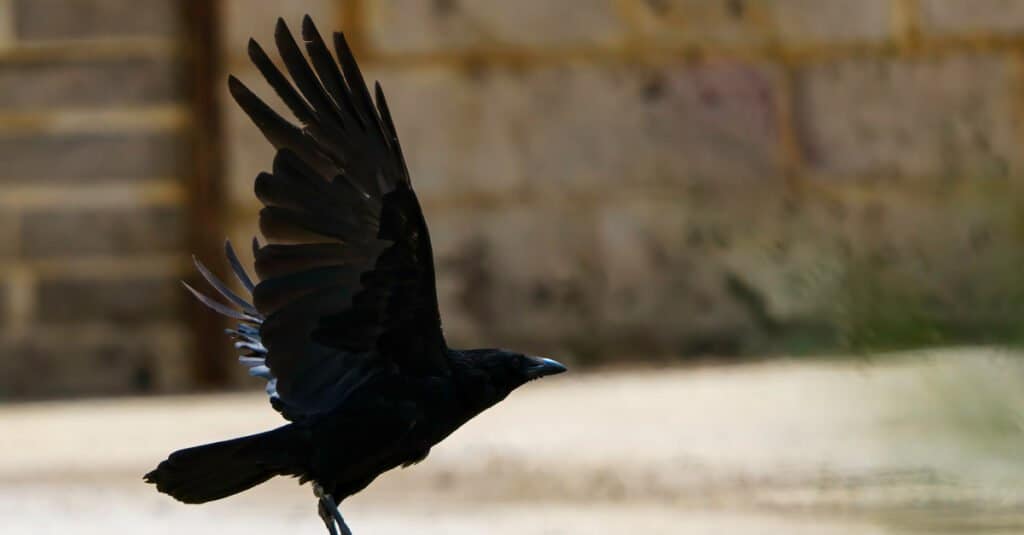
©iStock.com/Michael Gane
Gregarious and very intelligent, the crow is one of the most common of the passerines, or songbirds, even though its harsh cry is not at all song-like. Crows have many types of vocalizations besides the famous “caw” and can even mimic birds of prey. There are several species of crow, including the fish crow and the carrion crow, but nearly all of them are solid, iridescently black animals. They can be told from ravens, which are also black because they’re smaller and have a lighter build and a much different call. Not only the feathers but the bill and feet of the crow are black. Though they usually live about seven years in the wild, captive crows have been known to live for as long as 30 years.
#7: Black Panther
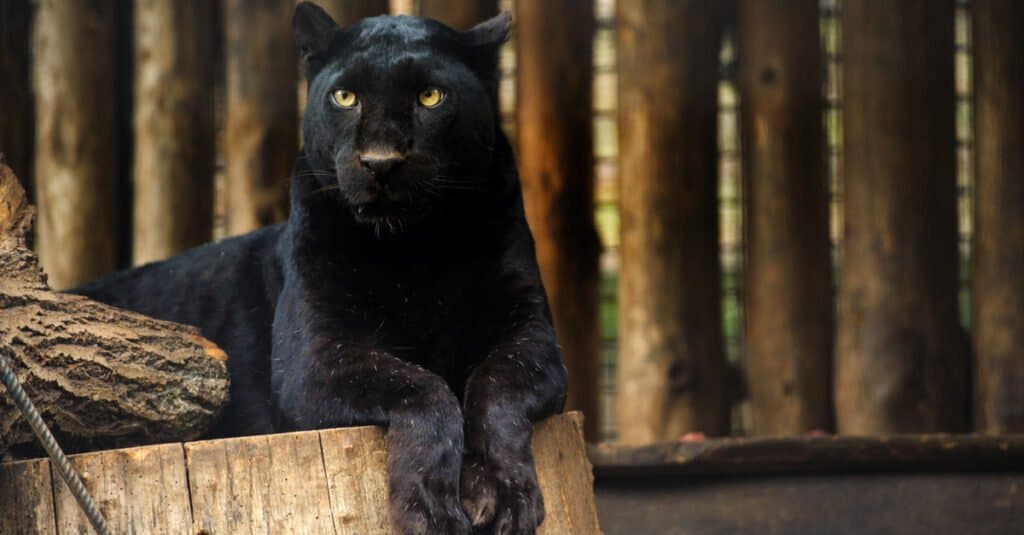
©Art_man/Shutterstock.com
Melanism is a condition where there is an unusual amount of dark pigment in the integument of an animal that is not usually black. The black panther is not its own species of big cat but the result of melanism in the jaguar found in Central and South America or the leopard found in Africa and Asia. The result is sensationally beautiful black animals whose spots a person can just about make out if they’re brave enough to get close to them. Interestingly, melanism is a recessive trait in the leopard and a dominant trait in the jaguar. Other than their black fur, melanistic jaguars and leopards have the same characteristics and behaviors as their standard relatives.
#6: Bonobo
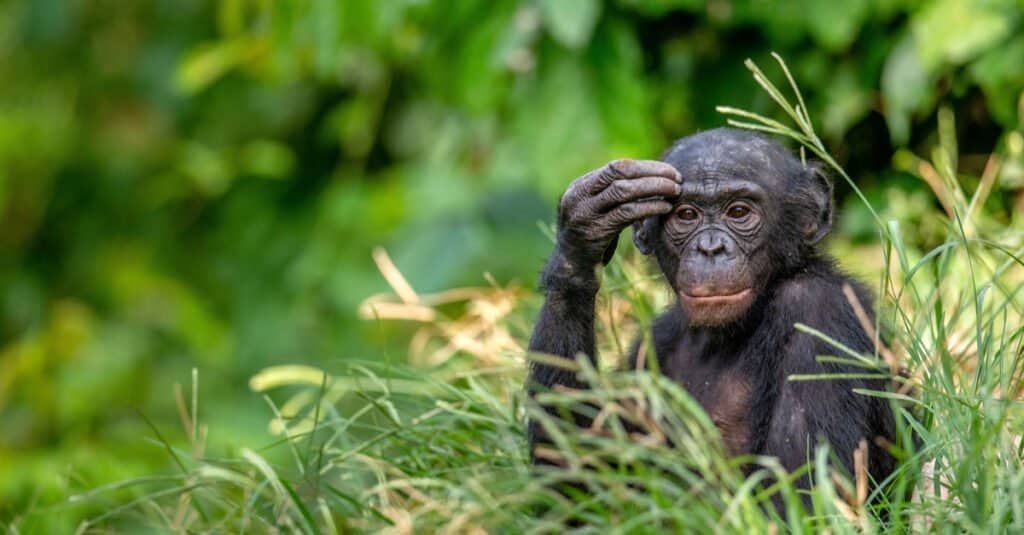
©Sergey Uryadnikov/Shutterstock.com
Also called the pygmy chimpanzee, this primate not only has black hair but black skin, though its lips are pink. It’s found in the forests of the Democratic Republic of Congo’s Congo Basin and eats fruit. Unlike the common chimpanzee, bonobo societies have a matriarchal cast to them. They’re led by a matriarch and females form strong alliances, but they may have an alpha male as a sort of enforcer. Bonobos are altruistic, cheerfully promiscuous, and are far less likely to murder each other than common chimpanzees or their close cousins, the human.
#5: Celebes Crested Macaque

©Matt_Williams/Shutterstock.com
Also known as the black ape, this monkey is only found in small areas in Sulawesi, formerly known as Celebes. Its skin and fur are completely black, though some animals may have some white hair around their shoulders. The only things that are not black about the black ape are its eyes, which are a remarkable reddish brown. Because its tail is vestigial, people mistake it for an ape, but it is a monkey.
The Celebes crested macaque has the long muzzle and prominent brows of a baboon and a funny tuft of hair on top of its head. It lives in the rainforest but stays mostly on the ground where it searches for fruit and small arthropods. The Celebes crested macaque is classified as critically endangered. In 2011 controversy arose when some of these macaques took selfies. This caused copyright problems as copyrights can’t be given to non-humans.
#4: Greater Ani
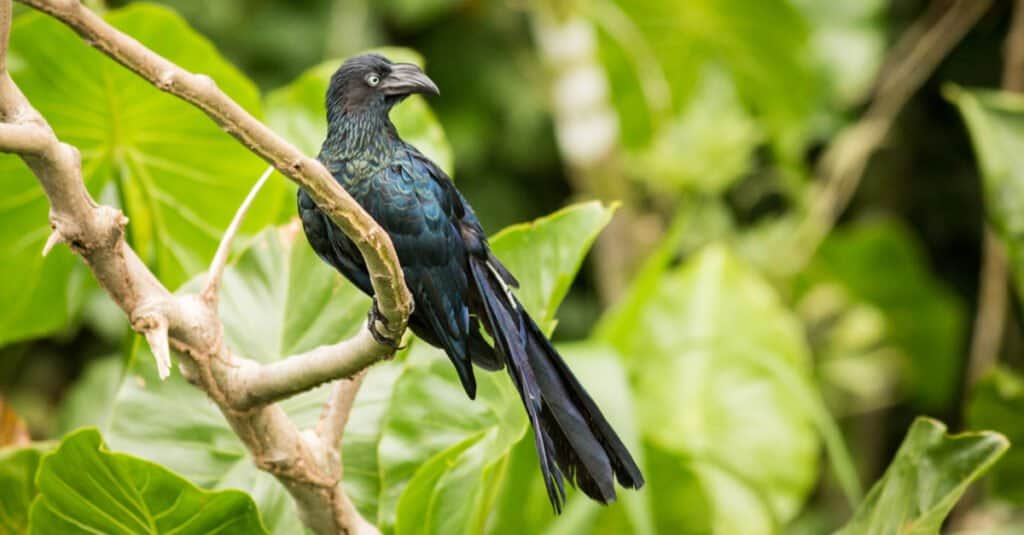
©Martin Grossman/Shutterstock.com
This blackbird can be told from other black animals like a crow or a raven by its large, ridged bill and a tail that’s longer in proportion to its body than a crow’s or a raven‘s. Its black feathers have an attractive blue gloss. It’s found near water in much of South America. The ani is a type of cuckoo, but unlike other cuckoos, the female doesn’t lay an egg in the nest of another species of bird then leaves. Indeed, the nest of the greater ani is built by several mating pairs, and the females lay their eggs in the same nest and take turns incubating them. A female may lay her eggs in another nest if she loses her clutch of eggs but only in the nest of another greater ani.
#3: Black Saddlebags Skimmer

©iStock.com/PaulReevesPhotography
Among the smallest black animals, this is a type of dragonfly that gets its name because black markings on its otherwise transparent wings make it look like it’s carrying saddlebags. As a skimmer, it belongs to the largest family of dragonflies. Found in North America, it is about 2 inches long and has a long, thin, black body, though some females may be speckled on their underparts. Like other dragonflies, it is a voracious predator and eats anything small enough to handle. Because of this, black saddlebags skimmers are welcome in gardens and around human habitations, for they enthusiastically dine on mosquitoes and other pests.
#2: Cactus Longhorn

©Charles T. Peden/Shutterstock.com
These shiny black beetles, also called Moneilema are known for their long antennae and the fact that they’re flightless. This is because their front wings have fused and so can’t open up. Adults are between half an inch and 1.3 inches long.
Found in the deserts of Mexico and the United States, the beetle feeds on cacti, especially saguaro, prickly pear, and cholla. Though the adults feed on top of the plants, the grubs can bore into the cactus’ roots and may kill it. Adults appear in May or June and keep feeding until the end of September. They’ll protect themselves from the hot desert sun by hiding on the lower parts of the cactus. The female lays her eggs in a place on the cactus where a limb has been chewed off, and the grubs burrow within and even pupate inside of the plant. They chew their way out when they’re ready to emerge. There are about 20 species of Moneilema.
#1: Indigo Snake

©Patrick K. Campbell/Shutterstock.com
This harmless snake, also called the cribo is prized for the beauty of its smooth, iridescent, blue-black scales and its usefulness in keeping down populations of rodents and other pests. Found from the southern United States down into Mexico, Central America, and South America, it can grow to 10 feet long and weigh about an ounce. The indigo snake is the largest snake native to the United States. Males are usually longer than females.
The indigo snake hunts during the day and will take amphibians, small rodents, and birds. It will even take other snakes, even venomous ones, and baby turtles, which most other snakes avoid. Sometimes the snake eats prey alive and sometimes it beat its prey to death before swallowing it. Despite this, the indigo snake is docile to humans and only bites when it is really under duress. Because of this, these slick black animals were sought after as pets until this was banned. Indigo snakes can live as long as 25 years.
Summary
Dark coloring is nothing new in the animal world and is generally thought to help hide animals while they are moving around at night. There is some evidence that dark-colored birds, such as crows or the Greater Ani, may have a coloring that is not visible to human eyes. Given that we can’t see these colors or know what they might look like, we are not yet able to measure or record them. It is intriguing to think about colors that we can’t perceive, however, we don’t need to see them to know that these dark-colored creatures are beautiful.
Summary Of 10 Incredible Black Animals
| Rank | Species |
|---|---|
| 1. | Indigo Snake |
| 2. | Cactus Longhorn |
| 3. | Black Saddlebags Skimmer |
| 4. | Greater Ani |
| 5. | Celebes Crested Macaque |
| 6. | Bonobo |
| 7. | Black Panther |
| 8. | Crow |
| 9. | Wild Water Buffalo |
| 10. | Short-finned Pilot Whale |
The photo featured at the top of this post is © Sergey Uryadnikov/Shutterstock.com
Thank you for reading! Have some feedback for us? Contact the AZ Animals editorial team.






